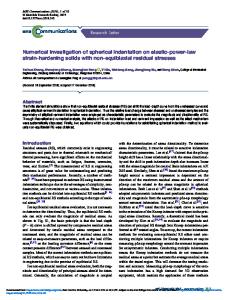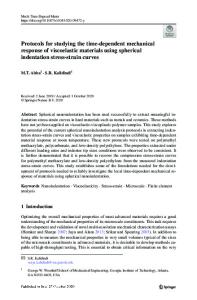Spherical indentation of ductile power law materials
- PDF / 508,964 Bytes
- 9 Pages / 612 x 792 pts (letter) Page_size
- 69 Downloads / 445 Views
Robert J. Asaro Department of Structural Engineering, University of California, San Diego, La Jolla, California 92093
Robert J. Sebring MST-7 Los Alamos National Laboratory, Los Alamos, New Mexico 87545 (Received 3 December 2003; accepted 20 May 2004)
A procedure for extracting simple constitutive parameters from microindentation tests is described. The analysis used to interpret the indentation tests is based on the analysis of the spherical indentation test developed by Hill et al. for power law materials. Indentation tests are supplemented by scanning interference microscopy of the residual indented surface profiles and a method is suggested for using the residual surface profiles to estimate the actual contact surface. This, in turn, allows for the construction of the entire stress versus strain curve.
I. INTRODUCTION
Hardness tests, especially those that make use of small indenters, offer the prospect of inexpensive, nondestructive ways to probe the constitutive response of elasticplastic materials. The exploration of these methods goes back nearly to the turn of the 20th century to the work of Brinell,1 Meyers,2 O’Neill,3 and Tabor.4 Since then, research has continued in an attempt to make such tests quantitative and capable of allowing the extraction of material parameters that are part of the material’s constitutive relations. Recent efforts include the work of Follansbee and Sinclair,5 Field and Swain,6 Chaudhri and co-workers,7 and Suresh and co-workers.8 It is of particular interest to develop methods based on such simple, nonintrusive tests that allow for the tracking of changes in material constitutive parameters, for example due to aging. The original methods laid out in this early work are reviewed below, especially since modern methods so strongly reflect the original concepts. Most of the more recent work has been concerned with developing more accurate methods for measuring the critical parameters appearing in the formalism, and for developing test methodology for obtaining data. We use these ideas along with the elegant analysis due to Hill et al.9 to demonstrate how constitutive parameters may be obtained by simple methods derived from the basic Brinell test method. We support this approach with novel surface topology measurements and accurate indentation measurements. Results for tantalum metal demonstrate the accuracy, and pitfalls, of the approach. DOI: 10.1557/JMR.2004.0363 J. Mater. Res., Vol. 19, No. 9, Sep 2004
http://journals.cambridge.org
Downloaded: 12 Nov 2014
This work is part of our ongoing broader investigation of the phenomenology of the Brinell test applied to materials that have complex constitutive descriptions, specifically those that are described by the mechanical threshold stress (MTS) model originally developed by Follansbee and Kocks10 for ductile metals and alloys. That effort will focus on exposing, through detailed numerical simulation and coupled experiment, the sensitivity of the phenomenology displayed in a Brinell test to variations in critical material para
Data Loading...











